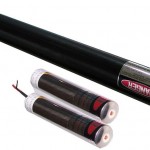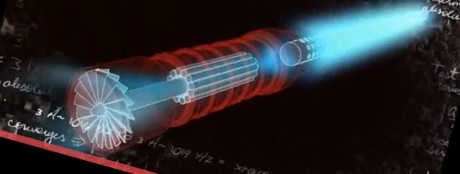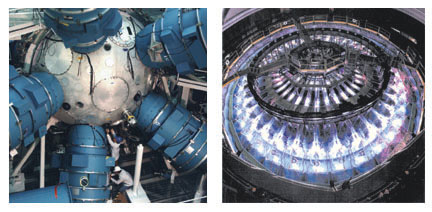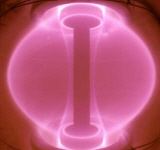3 Theories On How To Build A Real Life Lightsaber
Posted by Tensor on August 22nd, 2011Jedi Masters pass down the secret knowledge of constructing “an elegant weapon for a more civilized age” to their young Padawan learners. We are not fortunate enough or have the midiclorean count (ech, think I gagged a little there) to deserve this important honor. So let us try to figure out how this magnificent and terrifyingly dangerous weapon works on our own. There are several characteristics that that should give us clues. For example, they have a round blade made of a luminous substance. The blade would have to be able to cut through a human’s arm as if it was made of cake. It grows gradually when turned on and it can deflect blaster shots and other lightsabers. This should be enough.
Smoke and Mirrors
The most obvious and easy explanation is that a light saber is exactly what the name implies, a laser sword. A laser of sufficient power would cut, or rather burn, through flesh as easily as displayed. But how is it that it is of a limited size and how come the power does not run out. Well this could be explained by a mirror at the end of the light “blade” the mirror could be suspended in space by electric or magnetic (or both) fields and slowly adjusted out from the hilt. This would make the whole blade a Laser cavity and would allow for a reasonable consumption of power as the laser light is not lost except when cutting. Of course this explanation would not explain how you can fence with other lightsaber toting bad guys. The laser blades would just go through each other as easily as the blaster shot. It would make for really short fights . Also the mirror could be easy to remove or destroy.
adjusted out from the hilt. This would make the whole blade a Laser cavity and would allow for a reasonable consumption of power as the laser light is not lost except when cutting. Of course this explanation would not explain how you can fence with other lightsaber toting bad guys. The laser blades would just go through each other as easily as the blaster shot. It would make for really short fights . Also the mirror could be easy to remove or destroy.
Fan Favorite
In a recent TV show Dr. Michiu Kaku proposed that a light saber was actually a plasma torch with a titanium fan in the hilt and telescoping ceramic blade with teeny holes on it for the scorching plasma to come out. Although this explanation covers all the basics it left me with a bad feeling about that. With much respect to the closest thing to a Yoda around, allow me to disagree. Plasma is OK, we like plasma; it burns like a mother. The part that I do not like is the ceramic perforated blade. It is clunky it would mean that a guy with a better “space ceramic” would break your saber in two, to say nothing of a good vibroblade. It would also make a horrible glass breaking sound as it does. Also the fan, dude, fans are noisy and not in the good starwarsy way.
Finally the blades would leave a trail of burning plasma and although really cool looking in a very trippy way, it would not match what we see on the screen. Sorry Kaku, these are not the sabers we are looking for, move along.
It’s All About Magnets, Baby!
So Star Wars is not set in the future but the long ago past in a galaxy far far away. However, the galactic Republic civilization was very darned advanced as galactic civilizations go. Without getting into all the crystal and focusing ring lore of the BioWare games, we can imagine that civilization can build things that we can but make them very light and portable. With that in mind, I propose that the light sabers are really portable electromagnetic containment fusion plasma devices.
In many present day thermonuclear Fusion experiments large magnetic and electric fields are used to make Magnetic Bottles. Within these invisible vessels hot plasma is contained and heated. I can imagine that the hilt of Luke Skywalker’s weapon is just that: a magnetic field generator that extends out of the hilt creating a containment field where a very hot fusionable gas plasma can reside. When the saber is turned on the field extends slowly as stored power is used to erect it. You can imagine superconducting coils within the hilt emitter that give the correct shape to the magnetic bottle. This would explain why the blade shape is cylindrical and symmetric. Once the field is ready, radio frequency exited gas can be introduced within the growing space in the force field. As futuristic as this sounds, we do this in labs every day with very large machines. The whole thing would be very efficient too, and once the field is erected little power is needed to maintain it. Besides, a very small amount of gas could be allowed to undergo fusion, powering the device in accordance to E=mc2. Different gas at different temperatures would account for the varying colors just like Stellar Spectra. Luke’s original blade, if you were wandering, was a nice 8,600K Atomic Hydrogen with just a pinch of gaseous Iron, just right for baby blue.
The coolest part about this is that you could fence easily because your opponent would also have a plasma filled electromagnetic field as a blade and so it would be like trying to get magnets of similar polarity to touch. Also the hot plasma could be tuned to absorb or reflect the incoming laser light or particle weapon discharge.
In the end, however, it all comes to personal preference. If you would like to go around the galaxy with a flashlight on steroids or with a flaming tube of space porcelain china as a weapon, be my guest. I’m sure that some of the denisens of the galaxy might be impressed. Jawas, they like junk.
I for one, would really like to stick with the portable thermonuclear powered fusion plasma device while gallivanting through the cosmos. Maybe its just me, but hey, who doesn’t need a bit more power in their “more elegant weapon” anyway?
Want to find out more about thermonuclear fusion? Check this out.




August 23rd, 2011 at 6:30 am
Yes, yes. This is all well and good, Tensor, but I quote Justin.
“When will Then be Now?!”
Serriously though, awesome article.
August 23rd, 2011 at 5:50 pm
Well, in a word “Soon” . Stay tuned for my expose to be titled “A Man and his Helmet, the Big Helmet Story” just don’t ask me how the Schwartz works. Thanks for the cool comment. Glad you liked it!
August 25th, 2011 at 4:37 am
I Love this. Awesome article Tensorguy
September 4th, 2011 at 12:15 am
[…] Weird Things » Blog Archive » 3 Theories On How To Build A Real … […]
September 14th, 2011 at 11:48 pm
my way is co2 laser, a morphing semi-convex-len that change the laser focal point of 60 different length a second. Maybe more than 60. Still that would make a stretch prism with a rather strange topping end of the light
September 14th, 2011 at 11:48 pm
my way is co2 laser, a morphing semi-convex-len that change the laser focal point of 60 different length a second. Maybe more than 60. Still that would make a stretch prism with a rather strange topping end of the light